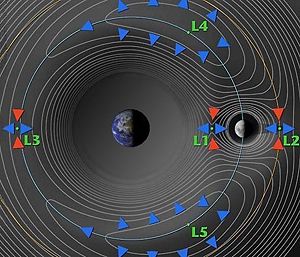
Kordylewski cloud
Encyclopedia

Lagrangian point
The Lagrangian points are the five positions in an orbital configuration where a small object affected only by gravity can theoretically be stationary relative to two larger objects...
s of the Earth–Moon system. They were first reported by Polish
Poland
Poland , officially the Republic of Poland , is a country in Central Europe bordered by Germany to the west; the Czech Republic and Slovakia to the south; Ukraine, Belarus and Lithuania to the east; and the Baltic Sea and Kaliningrad Oblast, a Russian exclave, to the north...
astronomer Kazimierz Kordylewski
Kazimierz Kordylewski
Kazimierz Kordylewski was a Polish astronomer.In 1956 he claimed the discovery of the Kordylewski clouds which are believed to be large transient concentrations of dust at the Trojan points of the Earth-Moon system. The existence of the clouds is still contested.-External links:* *...
in the 1960s, but there is still controversy as to whether they actually exist, due to their extreme faintness. They may be transient
Transient astronomical event
A transient astronomical event, often simply called in context by astronomers a transient, is an astronomical object or phenomenon which can be observed for a short period of time...
phenomena, as the and points are unstable, due to the perturbations
Perturbation (astronomy)
Perturbation is a term used in astronomy in connection with descriptions of the complex motion of a massive body which is subject to appreciable gravitational effects from more than one other massive body....
of the inner planets.
Discovery and observation
The existence of a photometricallyPhotometry (astronomy)
Photometry is a technique of astronomy concerned with measuring the flux, or intensity of an astronomical object's electromagnetic radiation...
confirmable concentration of dust at the libration points was predicted by Professor J. Witkowski in 1951.
The clouds were first seen by Kordylewski in 1956. Between 6 March and 6 April, 1961 he succeeded in photographing two bright patches near the libration point. During the observation time the patches hardly appeared to move relative to L5. The observations were taken from the mountain Kasprowy Wierch.
In 1967, J. Wesley Simpson made observations of the clouds using the Kuiper Airborne Observatory
Kuiper Airborne Observatory
The Gerard P. Kuiper Airborne Observatory was a national facility operated by NASA to support research in infrared astronomy. The observation platform was a highly modified C-141A jet transport aircraft with a range of 6,000 nautical miles , capable of conducting research operations up to 48,000...
.
The existence of the Kordylewski clouds is still under dispute. The Japanese Hiten
Hiten
The Hiten Spacecraft , given the English name Celestial Maiden and known before launch as MUSES-A , part of the MUSES Program, was built by the Institute of Space and Astronautical Science of Japan and launched on January 24, 1990...
space probe, which passed through the libration points to detect trapped dust particles, did not find an obvious increase in dust levels above the density in surrounding space.
Appearance
The Kordylewski clouds are a very faint phenomenon, comparable to the brightness of the GegenscheinGegenschein
The gegenschein is a faint brightening of the night sky in the region of the antisolar point.- Explanation :Like the zodiacal light, the gegenschein is sunlight reflected by interplanetary dust...
. They are very difficult to observe from Earth but may be visible to the unaided eye in an exceptionally dark and clear night sky. Most claimed observations have been made from deserts, at sea, or from mountains. The clouds appear somewhat redder than the Gegenschein, indicating that they may be made of a different kind of particle.
The Kordylewski clouds are located near the and Lagrange points of the Earth–Moon system. They are about 6 degrees in angular diameter
Angular diameter
The angular diameter or apparent size of an object as seen from a given position is the “visual diameter” of the object measured as an angle. In the vision sciences it is called the visual angle. The visual diameter is the diameter of the perspective projection of the object on a plane through its...
.
The clouds can drift up to 6 to 10 degrees from those points. Other observations suggest they move around the libration points in ellipses of about 6 by 2 degrees.

